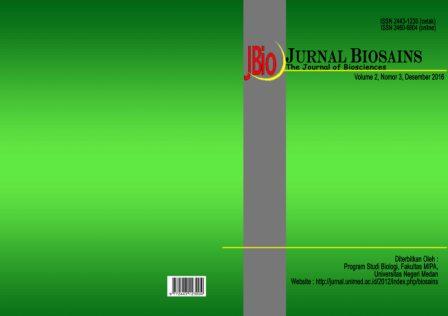POPULASI DAN JENIS LALAT BUAH YANG BERASSOSIASI DENGAN TANAMAN MARKISA DATARAN RENDAH ( Passiflora edulis Sims f. flavicarpa Deg)
DOI:
https://doi.org/10.24114/jbio.v2i3.4962Abstract
Pengembangan markisa dataran rendah khususnya markisa kuning ( Passiflora edulis Sims f. flavicarpa Deg) di Kecamatan Medan Tuntungan dihadapkan pada permasalahan tingginya serangan lalat buah.Tujuan penelitian adalah memperoleh informasi tentang jenis lalat buah yang berasosiasi dengan tanaman markisa dataran rendah.Penelitian dilakukan di Desa Sidomulyo dimana tanaman markisa ditanam dengan beberapa ketinggian rambatan. Pemasangan perangkap lalat buah menggunakan model perangkap Steiner ·yang sudah dimodifikasi dengan menggunakan botol air mineral bekas ukuran 1500 ml dan senyawa methyl eugenol. Ditemukan dua jenis lalat buah yaitu Bractocera dorsalis dan B.umbrosa. B.dorsalis mendominasi jenis lalat buah pada tanaman markisa. B.umbrosa mendominasi (90.24%) jenis lalat buah yang menyerang tanaman markisa di Sidomulyo dan B.umbrosa sebesar 9.76%. Kata kunci: markisa dataran rendah, perangkap, metyl eugenol, Bractocera dorsalis, B.umbrosaDownloads
Published
Issue
Section
License
For Authors Jurnal Biosains agree to the following terms:
Authors retain copyright and grant the Jurnal Biosains (JBIO) right of first publication with the work simultaneously licensed under a Creative Commons Attribution License (CC BY-SA 4.0) that allows others to share (copy and redistribute the material in any medium or format) and adapt (remix, transform, and build upon the material) the work for any purpose, even commercially with an acknowledgement of the work's authorship and initial publication in JBIO (Jurnal Biosains)
Authors are able to enter into separate, additional contractual arrangements for the non-exclusive distribution of the journal's published version of the work (e.g., post it to an institutional repository or publish it in a book), with an acknowledgement of its initial publication in JBIO (Jurnal Biosains)
Authors are permitted and encouraged to post their work online (e.g., in institutional repositories or on their website) prior to and during the submission process, as it can lead to productive exchanges, as well as earlier and greater citation of published work (See The Effect of Open Access).


